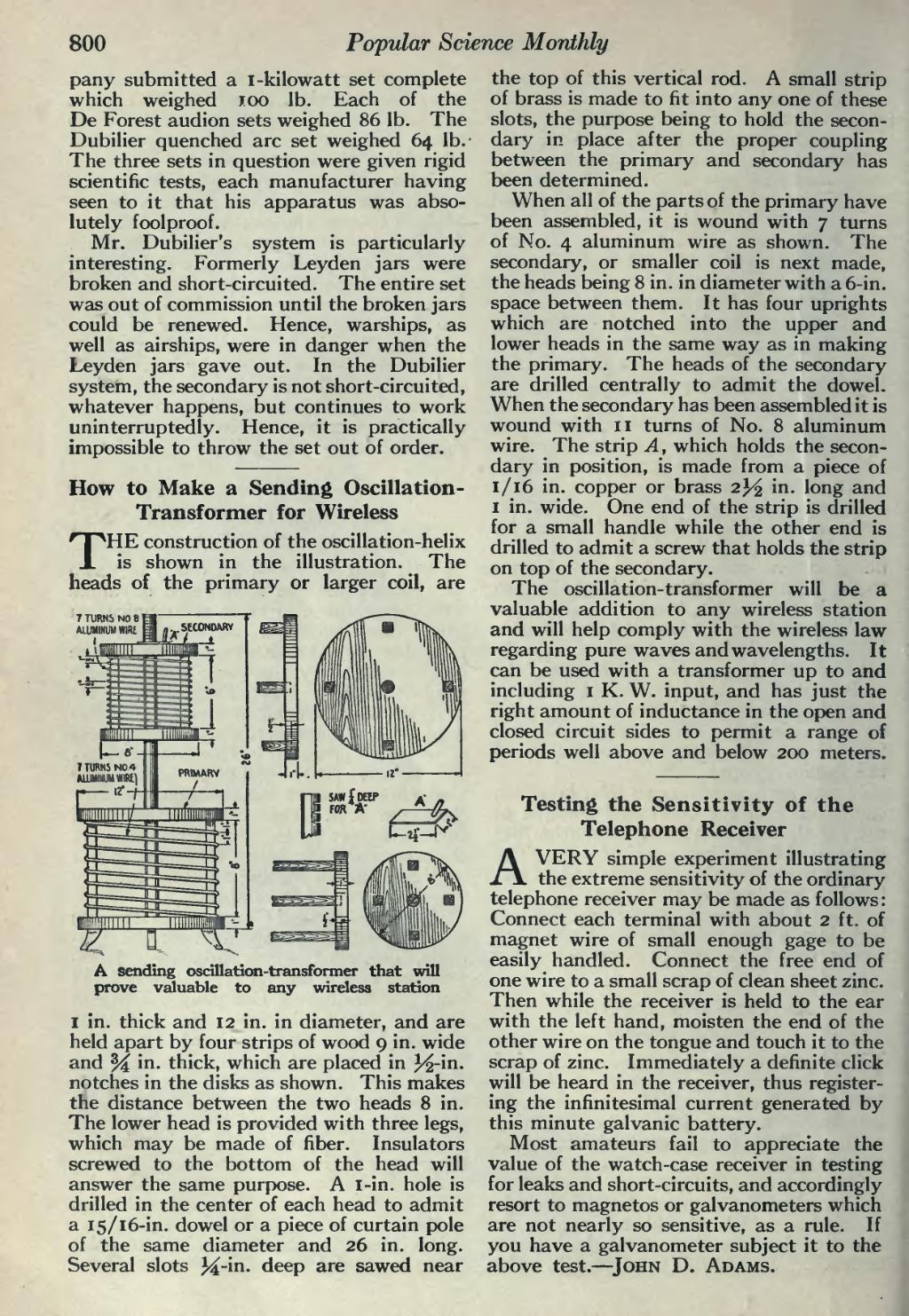800
��Popular Science Monthly
��pany submitted a i -kilowatt set complete which weighed lOO lb. Each of the De Forest audion sets weighed 86 lb. The Dubilier quenched arc set weighed 64 lb. The three sets in question were given rigid scientific tests, each manufacturer having seen to it that his apparatus was abso- lutely foolproof.
Mr. Dubilier's system is particularly interesting. Formerly Leyden jars were broken and short-circuited. The entire set was out of commission until the broken jars could be renewed. Hence, warships, as well as airships, were in danger when the Leyden jars gave out. In the Dubilier system, the secondary is not short-circuited, whatever happens, but continues to work uninterruptedly. Hence, it is practically impossible to throw the set out of order.
��How to Make a Sending Oscillation - Transformer for Wireless
THE construction of the oscillation-helix is shown in the illustration. The heads of the primary or larger coil, are
��7 TURNS NO 8
ALUMINUM WIRE
���A sending oscillation-transformer that will prove valuable to any wireless station
I in. thick and 12 in. in diameter, and are held apart by four strips of wood 9 in. wide and ^ in. thick, which are placed in ^-in. notches in the disks as shown. This makes the distance between the two heads 8 in. The lower head is provided with three legs, which may be made of fiber. Insulators screwed to the bottom of the head will answer the same purpose. A i-in. hole is drilled in the center of each head to admit a 15/16-in. dowel or a piece of curtain pole of the same diameter and 26 in. long. Several slots M-in. deep are sawed near
��the top of this vertical rod. A small strip of brass is made to fit into any one of these slots, the purpose being to hold the secon- dary in place after the proper coupling between the primary and secondary has been determined.
When all of the parts of the primary have been assembled, it is wound with 7 turns of No. 4 aluminum wire as shown. The secondary, or smaller coil is next made, the heads being 8 in. in diameter with a 6-in. space between them. It has four uprights which are notched into the upper and lower heads in the same way as in making the primary. The heads of the secondary are drilled centrally to admit the dowel. When the secondary has been assembled it is wound with 11 turns of No. 8 aluminum wire. The strip A , which holds the secon- dary in position, is made from a piece of 1/16 in. copper or brass 2)^ in. long and I in. wide. One end of the strip is drilled for a small handle while the other end is drilled to admit a screw that holds the strip on top of the secondary.
The oscillation-transformer will be a valuable addition to any wireless station and will help comply with the wireless law regarding pure waves and wavelengths. It can be used with a transformer up to and including i K. W. input, and has just the right amount of inductance in the open and closed circuit sides to permit a range of periods well above and below 200 meters.
��Testing the Sensitivity of the Telephone Receiver
AVERY simple experiment illustrating the extreme sensitivity of the ordinary telephone receiver may be made as follows : Connect each terminal with about 2 ft. of magnet wire of small enough gage to be easily handled. Connect the free end of one wire to a small scrap of clean sheet zinc. Then while the receiver is held to the ear with the left hand, moisten the end of the other wire on the tongue and touch it to the scrap of zinc. Immediately a definite click will be heard in the receiver, thus register- ing the infinitesimal current generated by this minute galvanic battery.
Most amateurs fail to appreciate the value of the watch-case receiver in testing for leaks and short-circuits, and accordingly resort to magnetos or galvanometers which are not nearly so sensitive, as a rule. If you have a galvanometer subject it to the above test. — ^John D. Adams.
�� �
